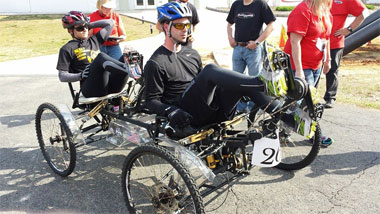
Sam Oltman, front, an SIU Carbondale junior in mechanical engineering from Henry, and Kelby Rogers, a sophomore in mechanical engineering from McHenry, prepare to take one of the rovers they built onto the course during NASA’s annual Human Exploration Rover Challenge last week in Huntsville, Ala. The event, previously known as the “moonbuggy race,” saw SIU’s teams finish second and third, the highest finish for the university since it began competing in 1998.
April 18, 2014
Students shine at NASA’s ‘Rover Challenge’
CARBONDALE, Ill. -- Engineering students at Southern Illinois University Carbondale finished in two of the three top spots at NASA’s annual Human Exploration Rover Challenge last week in Huntsville, Ala.
The event, previously known as the “moonbuggy race,” saw SIU’s teams finishing second and third, the highest race finish for the university since it started sending teams in 1998.
According to NASA, 70 high school, college and university teams from 19 states, Puerto Rico, Germany, India, Mexico and Russia competed. All told, more than 500 students -- drivers, engineers and mechanics, plus team advisers and "cheering sections" -- took part in the event.
Rasit Koc, professor and chair in the Department of Mechanical Engineering and Energy Processes, said this year's competition was the largest in the event's history, with teams from all over the world participating
“Our mechanical engineering students entered the competition with two vehicles,” Koc said. “This is an outstanding achievement and I am very proud of their accomplishments.”
Tsuchin Philip Chu, professor in the Department of Mechanical Engineering and Energy Processes, acted as faculty adviser to the team. Koc credited him with guiding the team to success during the last several years.
“Last year, the team brought home a U.S. flag that was flown on the Space Shuttle Atlantis STS-135 Mission in 2011 when they won the Astronaut Neil A. Armstrong Best Design Award,” Koc said. “The team has done excellent job under the guidance of Professor Chu over the years.”
This year, SIU’s Team No. 2 finished second, while Team No. 1 finished in third place:
The team members and their hometowns include: Jess Pille, Hanna City; Kaylyn Shaw, Riverton; Nigel Doerge, Eldorado; Ifreke Umana, Carbondale; Roger Mast, Cadwell; Zachary Pringle, Marshall; Ryan Spencer, Marengo; Anthony Bolton, Washington; Kelsey Staggs, Carlyle; Wei Jun Lim, Kuala Lumpur, Malaysia; Adam Yun Wei Eel, Kuala Lumpur, Malaysia; Tengsong Ng, Ipoh, Perak, Malaysia; Sam Oltman, Henry; and Kelby Rogers, McHenry. Shaw is an electrical engineering major, while the rest of the team are mechanical engineering majors.
“This award shows our students' exceptional talent and hard work,” Koc said. “The students put together their educational backgrounds, hands-on experiences and showed their strength as a team to design, build and compete.”
The top teams earned their wins by posting the fastest vehicle assembly and race times in their divisions, while accumulating the fewest on-course penalties. The University of Puerto Rico at Humacao, Team 2, won the top prize in the college division.
NASA's Marshall Space Flight Center in Huntsville organizes the event, which builds on two decades of competitive student innovation in the NASA Great Moonbuggy Race.
The event in its current form challenges students to design, build and race lightweight, human-powered roving vehicles, solving technical problems along the way in the spirit and tradition of NASA’s can-do engineers. The students' most innovative vehicle and hardware designs could help inform NASA's development of rovers and other space transportation systems for future exploration missions.
The event also highlights the STEM fields -- science, technology, engineering and mathematics. Success in those fields is key to the agency’s future endeavors, as well as the nation’s continued leadership in industry and other areas.
